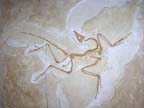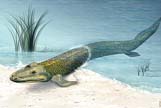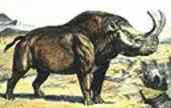 |
 |
 |
 |
 |
Produced
by the Population Genetics and Evolution class, Furman University |
||||
 |
 |
 |
 |
 |
Produced
by the Population Genetics and Evolution class, Furman University |
||||
 |
"The
RNA World" |
 |
||
| The “RNA World” hypothesis suggests that the original genetic material for life on Earth was ribonucleic acid (RNA) rather than deoxyribonucleic acid (DNA) and proteins. It proposes that proteins were not yet a part of biochemical reactions and RNA served to store genetic information as well as a catalyst. The hypothesis was created after it was realized that RNA can cleave or ligate phosphodiester bonds. Original RNA based life may then have evolved to use DNA and proteins, due to the fact that RNA is less efficient due to its instability and poorer catalytic properties. One key piece of evidence in support of the hypothesis is that the ribosome is a ribozyme, or a class of catalytic RNA. “Structural and biochemical analyses have found that the mechanisms central for translation are catalyzed by RNA, not protein” (Exploring Origins). RNA evolution has been tested through the use of SELEX (Systematic Evolution of Ligands by Exponential Amplification) experiments, which use large populations of RNA or DNA sequences to select for functional molecules (Tulane). |  |
|||
| Self-Splicing RNA, http://www.symplus.com/legacy/biowiki/_media/rcsb_image/1u6b.jpg | ||||
| The RNA World, http://nobelprize.org/nobel_prizes/chemistry/articles/altman/index.html, 1/16/10 Exploring Life's Origins, http://exploringorigins.org/nucleicacids.html, 1/17/10 Combinatorial Methods and Activity Selection, http://www.tulane.edu/~biochem/lecture/723/combinRNA.htm, 1/16/10 | ||||